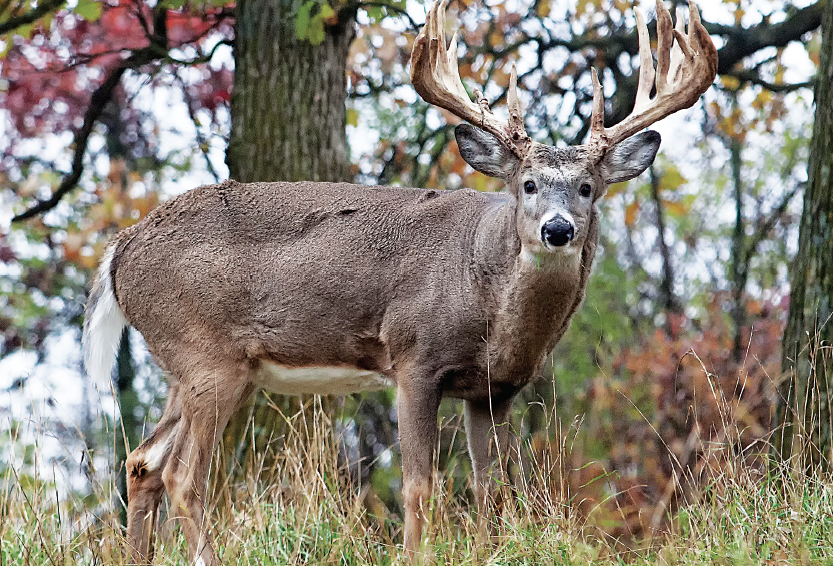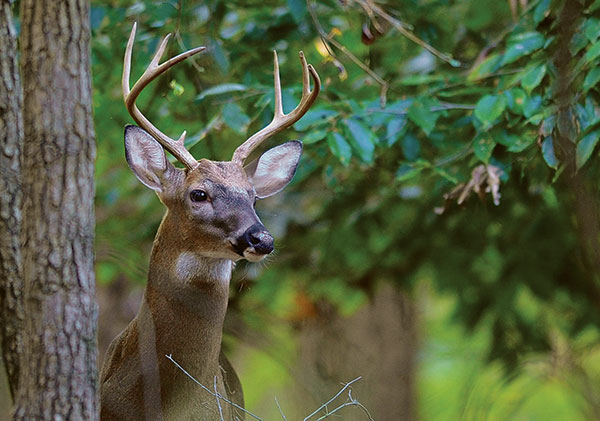Sometimes bad news can bring good luck.
On my second afternoon at Timberghost, morning rain clouds had drifted away and a brilliant autumn sun had turned the hardwoods into a particolored palette of red, yellow, maroon and gold. Head guide Mike Willems had just turned his vehicle onto a winding forest road when he surprised me with an intriguing question.
“Well, I have good news and bad news,” he began. “Which do you want first?”
“I’ll take the good news,” I responded somewhat excitedly.
“As guides, we rotate the order of selection for the different blinds and tomorrow morning we have first pick so we can get into a stand that’s covered up in big deer.”
“And the bad news,” I asked, not really looking forward to the answer.
“The stand we’re going to this afternoon doesn’t have as many big bucks as what you’ll see at the other food plots,” he said. “But I’m optimistic about one thing. Our trail cameras there have photographed a very unusual buck that carries a lot of mass and has exceptionally long brow tines.
“Maybe we’ll luck out and see him.”
Ten minutes later we were settled into a makeshift blind within an old farm wagon at the edge of a soybean plot. Mike had barely slid open the front window when we spotted a flash of tall antlers bobbing away through a dense wall of grasses.
“That’s him! That’s the buck I was telling you about. Hopefully he’ll stick around and come out later to feed on the beans.”
And so began our late-afternoon vigil on this preeminent Iowa preserve that offers some of the finest whitetail hunting in North America.
Shortly after our arrival on the previous day, my son Scott and I had a chance to visit with General Manager Mike Hine to learn more about Timberghost. Like so many great things in life, the preserve was the result of what some might call chance, while others would call it destiny.
In the early 1990s, Georgia sportsman Steve Fox arrived in Burlington, Iowa for his first-ever pheasant hunt. He had spent many years hunting quail and whitetails in the foothills of the Appalachian Mountains, but southeastern Iowa’s heavily wooded hollows, impenetrable creek bottoms and fields of native prairie grasses were new to him.
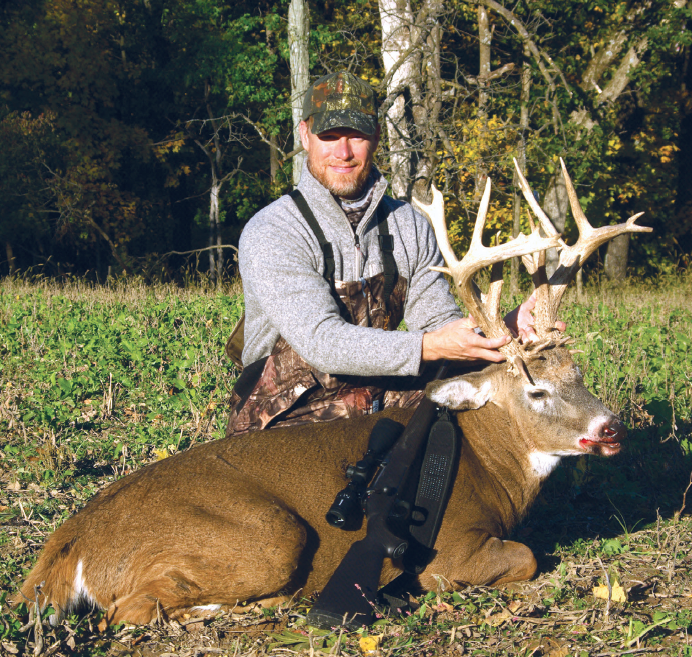
Scott took his buck from this shooting house next to a lush stand of turnips. The rack had more than 30 tines and stickers.
While walking up pheasants in a strip of sorghum, Fox jumped a “monster” whitetail with antlers considerably larger than anything he’d ever seen in Georgia. After the hunt, all he could think about was the huge buck and how he might come back to pursue it. Fox convinced the landowner to lease him the deer-hunting rights, and in the years to come he would return to take a number of bucks ranging from 140 to 180 inches.
Then, in the late ’90s, Fox was able to purchase the original farm and some of the surrounding lands, altogether encompassing some 1,000 acres. Unfortunately, due to Iowa’s whitetail draw system, Fox and other nonresidents were not allowed to hunt every year, which soon became quite frustrating to the avid hunter.
Fox was told that the only way he could hunt his property every autumn was to build a high fence around it. Fox proceeded to erect more than seven miles of high fencing and then built an impressive 13,000-square-foot lodge in 1999.
“I came on board a year later,” said Hine. “My challenge was to share our vision for a destination that would appeal to serious whitetail hunters who love chasing huge whitetails. I wanted to give them an opportunity to share a unique experience, a truly authentic hunt for trophy bucks on a beautiful piece of property where, since its inception, every decision has been linked to producing the most incredible whitetail habitat in the country.
“I want every one of our hunters to feel the excitement that Steve Fox felt when that monster buck jumped out of the sorghum strip thirty years ago.”
On my first afternoon hunt with Mike Willems, I had found myself enjoying that same excitement. We had settled into a blind along a narrow meadow anchored on each end by feeders—the perfect stage for our opening act at Timberghost. The action started when a spike buck emerged from the trees and then, from the opposite side came an aggressive little forkhorn walking stiff-legged with his ears pinned back.
The spike stared at the intruder and seemed to be thinking, I dare you to come closer.
The emboldened forkhorn did just that, approaching within a couple feet of the young spike’s nose. Finally intimidated, the smaller buck backed away and within minutes the two deer were grazing side-by-side as though they were lifelong friends.
Act two that day featured a much larger cast — at least a dozen does and fawns gathered around a feeder at the far end of the meadow. Then suddenly, as if someone had turned on a switch, the big boys started to enter at different points in the field. All were impressive, but one buck really stood out. His burnished antlers were wide and heavy, with seven long points on his right side and six on his left. He was truly magnificent but according to Mike, only three years old and thus off-limits to his hunters.
The excitement continued the next morning when Mike and I sat in a stand overlooking a patchwork of small fields planted in soybeans, turnips and wheat grass. In the dim pre-dawn light we could make out the dark forms of several bucks waiting for the feeder to spew out their morning ration of protein pellets. All told, there were five mature bucks, among them a heavy-horned 13-pointer with an eight-inch drop-tine as well as a 12-pointer with a beautifully symmetrical rack. Surprisingly, though a dense layer of clouds filled the sky, all of the deer finished feeding and headed back into the woods by 8 a.m.
Leaving the blind, Mike led me down a nearby ravine that plunged steeply through the hardwoods for some 500 feet. Long boulders and fallen trees framed the ravine where a spring-fed rivulet trickled down into a small pool. In this idyllic setting, I would have been content to plop down on a log and spend the rest of the day immersing myself in the sights and sounds around me. But I knew that another fine lunch by Chef Damion was waiting for us back at the lodge.
Later that afternoon, Mike and I were in the “bad news” field, hoping the big buck would return to feed. For nearly two hours we watched a parade of does and yearlings entering and leaving the food plot. Then finally, just as we were about to give up hope, the big buck stepped from a curtain of lilac-tinged grasses and walked directly toward our beanfield.
Heavy and tall, his antlers appeared almost ghostly white in the late-afternoon light. But what really caught my eye were his incredibly long brow tines, which gracefully curved upward until they were nearly even with the top of his rack.
Training his video camera on the buck, Mike whispered, “That’s him! Take your time. He’s not going anywhere.”
As the blast from my Barrett .30-06 echoed across the valley, the buck leaped high into the air and then bolted away, heading toward a narrow finger of woods jutting into the field. But he never made it that far. We found him piled up at the edge of the trees.
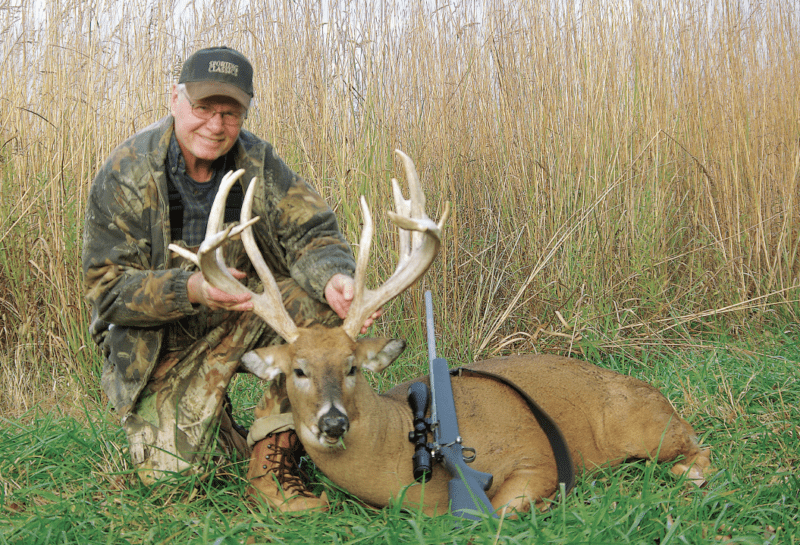
Chuck Wechsler with his “Bad News” buck. Heavy and tall, the rack gross-scored 187 inches B&C, with 10- and 12-inch brow tines. He dropped the buck with one shot from his .30-06 Barrett Fieldcraft.
Later, we measured the buck’s long brow tines at 12 and 10 inches and gross-scored the rack at 187 B&C points— very impressive. Especially for a Bad News buck.
On our last day at Timberghost, I joined Scott and his guide, Brian Field, in a big elevated stand at the edge of a 30-acre field covered in turnips. The winds were gusting to 40 miles-per-hour but they did nothing to deter a heavy-bodied buck from striding into the field and start gorging himself on the succulent plants.
“That’s a shooter,” Brian said while studying the buck through his binocs. “He not very wide, but he’s tall and heavy with all sorts of kickers. I’d guess that he’ll score in the high one-eighties.”
“I really like him,” Scott whispered back as he settled behind his new Sauer rifle. At the shot, the buck dropped straight down into the turnips.
Back at the lodge, closer examination of Scott’s beautiful trophy revealed 30 antler points and stickers and a gross score of 192 B&C.
Situated on a string of heavily wooded bluffs less than three miles from the Mississippi River, Timberghost is a truly spectacular setting for hunting trophy whitetails. But for us, seeing so many grand whitetails and taking two trophy bucks was only part of the equation. Each and every guide was extremely cordial, conscientious and hard working. The same held true for Chef Damion and the entire lodge staff.
We also discovered that Timberghost is a great place to make some new friends among more than a dozen hunters from around the country, all destined to make their own unforgettable memories at this storied lodge.
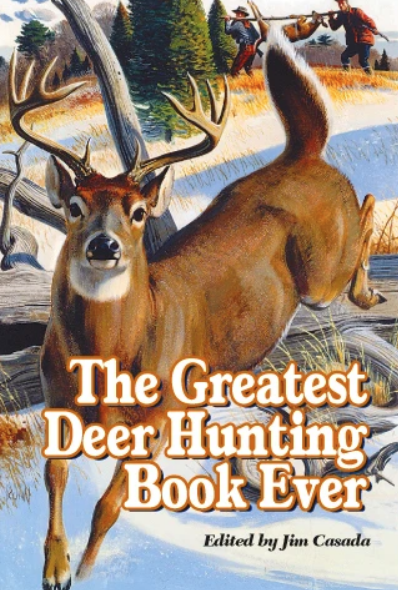 There’s something about the deer-hunting experience, indefinable yet undeniable, which lends itself to the telling of exciting tales. This book offers abundant examples of the manner in which the quest for whitetails extends beyond the field to the comfort of the fireside. It includes more than 40 sagas which stir the soul, tickle the funny bone, or transport the reader to scenes of grandeur and moments of glory.
There’s something about the deer-hunting experience, indefinable yet undeniable, which lends itself to the telling of exciting tales. This book offers abundant examples of the manner in which the quest for whitetails extends beyond the field to the comfort of the fireside. It includes more than 40 sagas which stir the soul, tickle the funny bone, or transport the reader to scenes of grandeur and moments of glory.
On these pages is a stellar lineup featuring some of the greatest names in American sporting letters. There’s Nobel and Pulitzer prize-winning William Faulkner, the incomparable Robert Ruark in company with his “Old Man,” Archibald Rutledge, perhaps our most prolific teller of whitetail tales, genial Gene Hill, legendary Jack O’Connor,Gordon MacQuarrie and many others.
Altogether, these carefully chosen selections from the finest writings of a panoply of sporting scribes open wide the door to reading wonder. As you read their works you’ll chuckle, feel a catch in your throat or a tear in your eye, and venture vicariously afield with men and women who instinctively know how to take readers to the setting of their story. Buy Now

